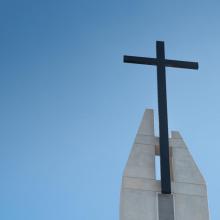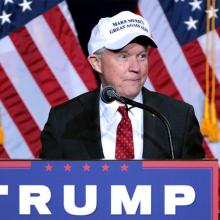u.s.-mexico border
The Trump administration on Sunday doubled down on its threat to shut down the southern border with Mexico, a day after it cut aid to Central American countries that President Donald Trump accused of deliberately sending migrants to the United States.
Iranian dissident Mohsen Kadivar and his wife, Zahra “Nikoo” Roodi, have seen it all before.
On. Feb. 16, the couple embraced after Kadivar’s hasty return from Berlin, where last month he had begun what he expected would be a semester-long fellowship.
Instead his plans were cut short by President Trump’s travel ban.
One year ago, Pope Francis visited the Mexican-U.S. border and prayed for migrants who have lost their lives seeking refuge in our country. His prayer transcended the dusty fences and united two countries in a silent cry for mercy on behalf of our brothers and sisters who died on their journey.

Image via Ryan Bodrick Beiler/Shutterstock.com
On Feb. 16 immigrants in Washington, D.C., plan to go on strike from work and other economic engagements, creating a “Day Without Immigrants,” just as immigrants in Wisconsin did on Feb. 13, reports the Washingtonian.
A flyer advertising the “Day Without Immigrants” calls for immigrants to avoid shopping, going to work, and eating at restaurants.
Sessions has long been, in the words of one prominent immigration advocate, the “most anti-immigrant senator in the chamber.” When George W. Bush, a self-styled “compassionate conservative” and born-again Christian, pushed a comprehensive immigration reform bill in 2007 that was supported by many business and law-enforcement officials, Sessions railed against what he called the “no illegal alien left behind bill” and led the charge against the failed effort. “Good fences make good neighbors,” he said at a press conference the year before.

Image via Thanate Rooprasert/Shutterstock.com
First came the mayors of New York, Chicago, and Seattle declaring their cities “sanctuaries”, and saying they will protect undocumented immigrants from President-elect Donald Trump’s plan to deport them.
Then thousands of students, professors, alumni, and others at elite universities, including Harvard, Yale, and Brown, signed petitions, asking their schools to protect undocumented students from any executive order.
Now, religious congregations, including churches and synagogues, are declaring themselves “sanctuaries” for immigrants fleeing deportation.

Pope Francis at a general audience, April, 30, 2014. softdelusion66 / Shutterstock.com
Do you remember the video clips of 5-year-old Sophie Cruz dashing across Constitution Avenue to Pope Francis’s popemobile during his visit to Washington, D.C., last September? The story of that encounter went viral: a young child with undocumented parents from Mexico who was granted permission to approach the pope, give him a letter, and receive a hug.
At the time, many seemed surprised by encounters like these during the pope’s U.S. trip — particularly that he would choose to make personal contact with the realities faced by marginalized populations. But this encounter-centered approach has been Francis’ way of operating since the outset of his pontificate.
[Gilberto] shared about the man who had been deported at 51 years old after living in the U.S. for 50 years. Because this man’s parents came to the U.S. when he was 6 months old, he knew no other home than that of the U.S. When he landed in Tijuana, it not only felt like a foreign land, but he didn’t even know Spanish.
He shared about the U.S. military veteran who served in Iraq and Afghanistan but after serving his time in war zones, was deported to Mexico.
He shared about the man who had recently been deported and was now desperately trying to return to his wife and young children in the U.S.
With each story, the layers of isolation, dehumanization, and misunderstanding began to be peeled back. We had all heard the stories of deportation in the headlines, but none of us had come face to face with the humans behind the story.
Mesmerized by this sage who cast such a strong aroma of Jesus, we asked, “What would you encourage us to say to our congregations regarding the plight of the immigrant?”
He quickly responded with words I’ll never forget:
“Tell them to read their Bibles. Jesus told us to care for three types of people: the orphan, the widow, and the stranger. It’s been 2,000 years and we’re still doing a pretty bad job.”
I am not a politician, so I’m not an expert on immigration policies.
I am not an economist, so I’m not an expert on the economic benefits or burdens of immigration.
But I am a public theologian. I try to understand how we can participate with God in setting things right, healing the world, and reconciling human beings with one another, with the world, and with God.





